
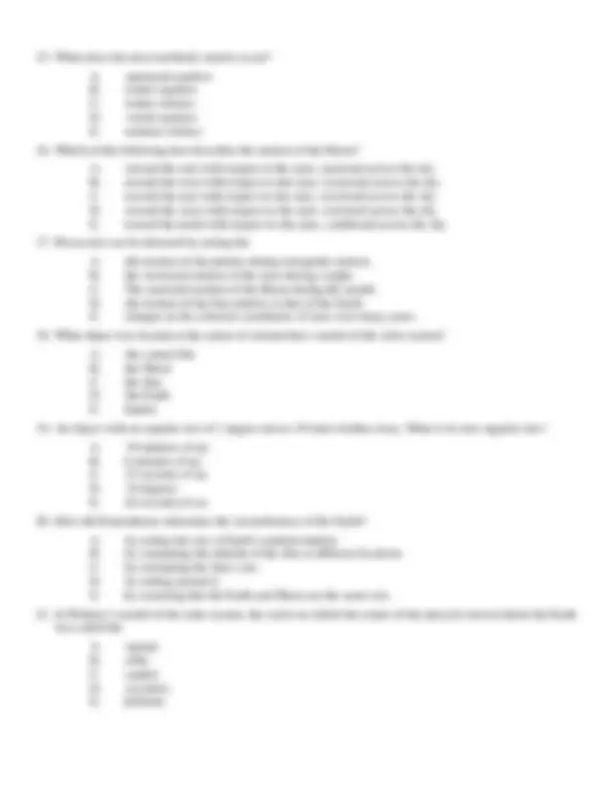
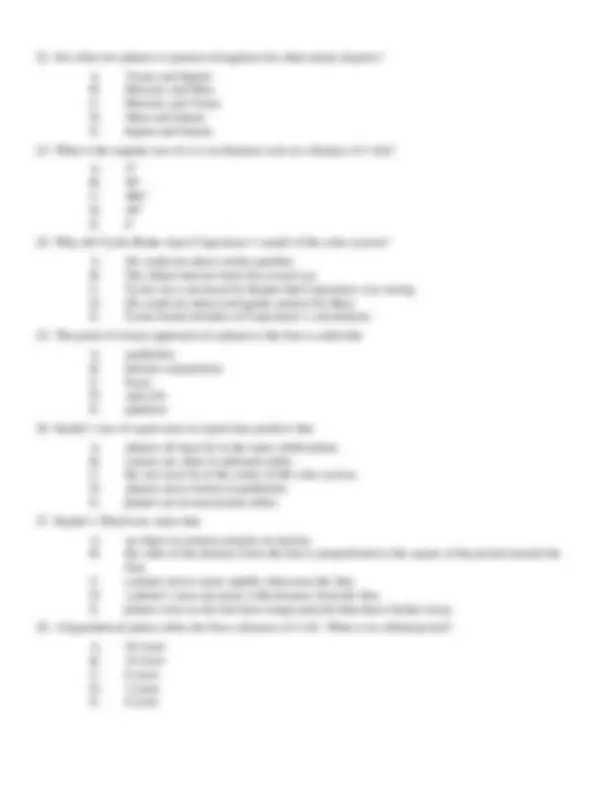
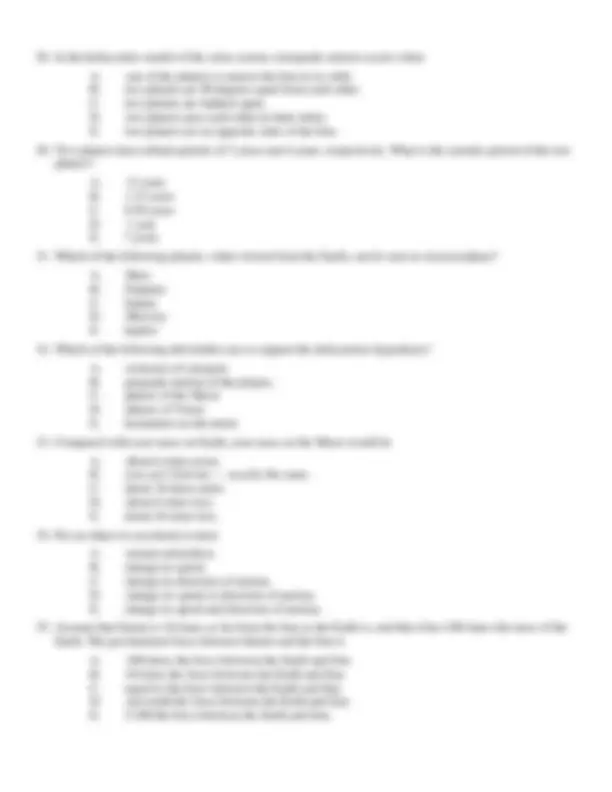
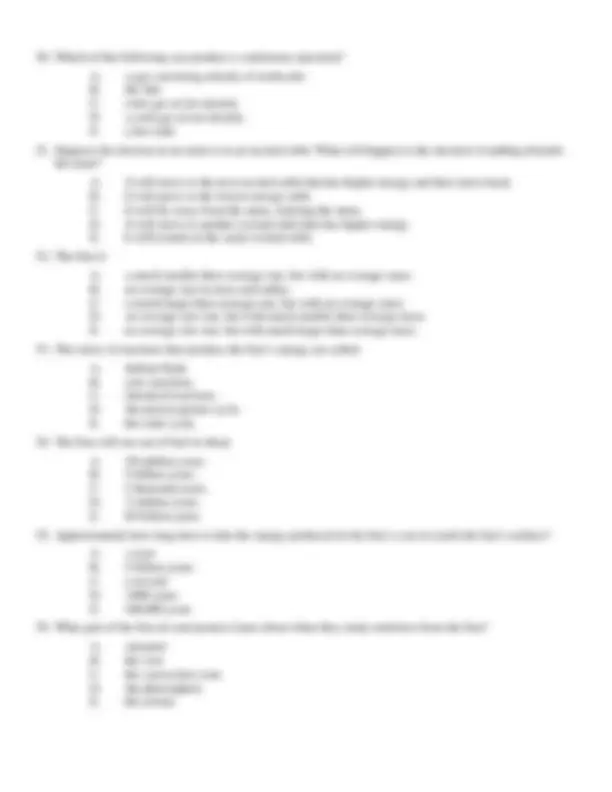
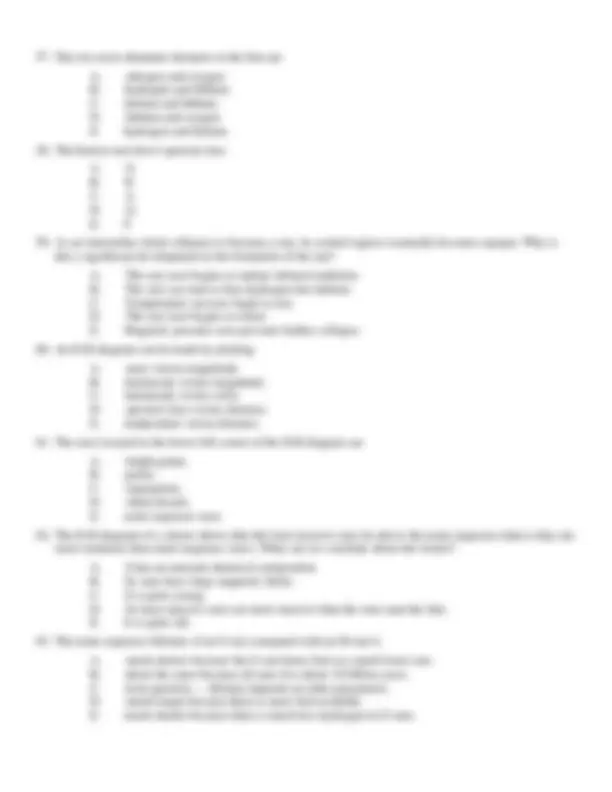
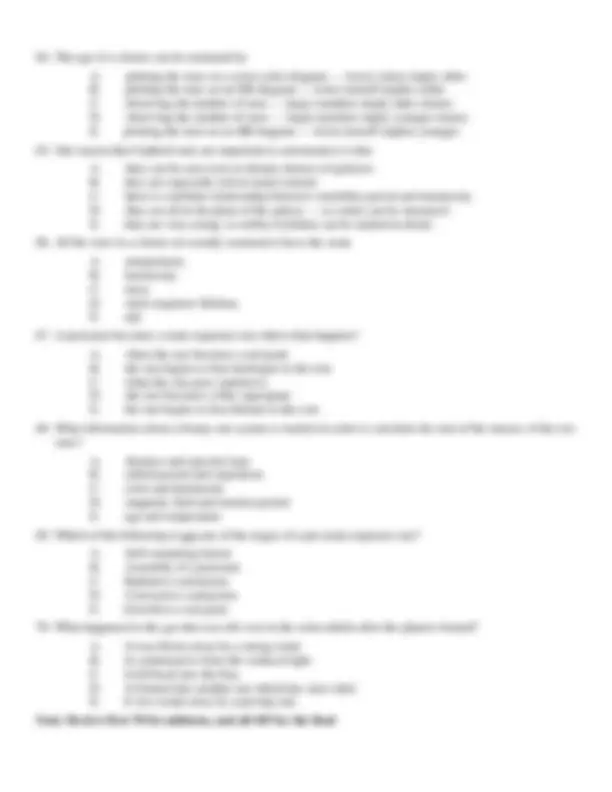
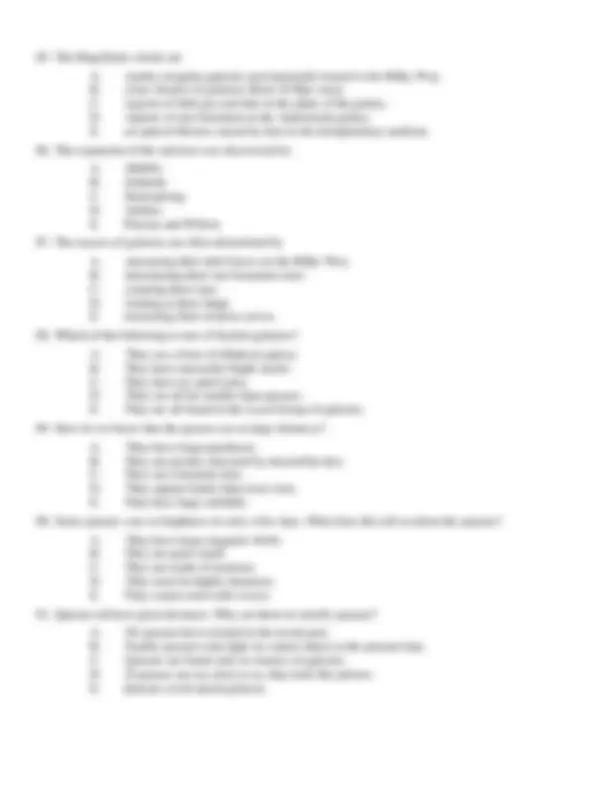
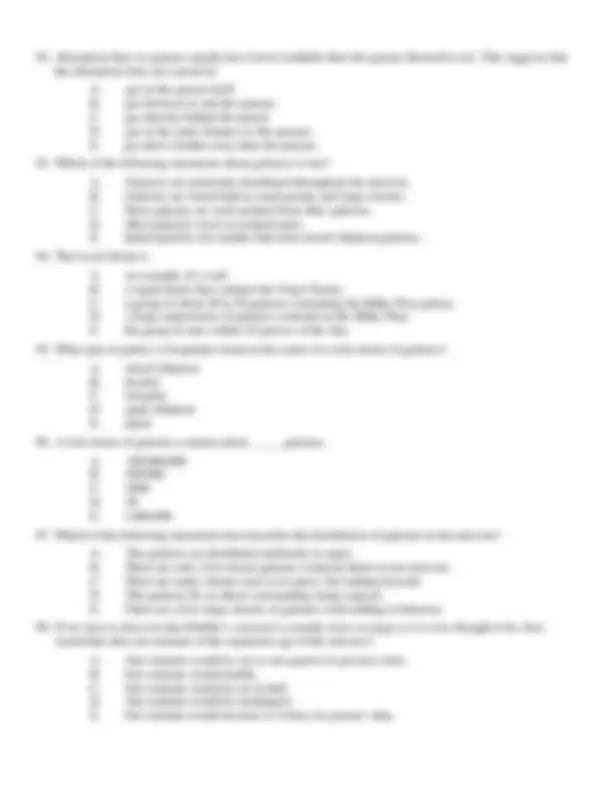
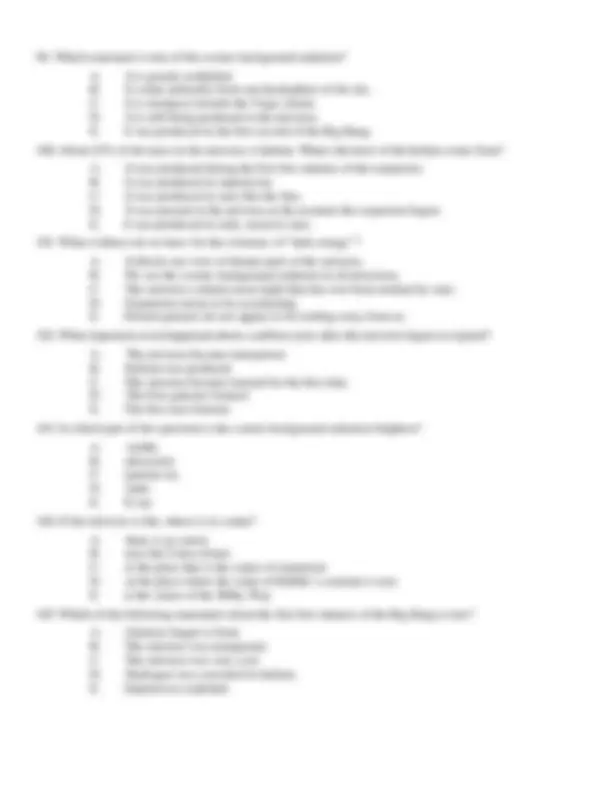


Study with the several resources on Docsity

Earn points by helping other students or get them with a premium plan


Prepare for your exams
Study with the several resources on Docsity

Earn points to download
Earn points by helping other students or get them with a premium plan
Community
Ask the community for help and clear up your study doubts
Discover the best universities in your country according to Docsity users
Free resources
Download our free guides on studying techniques, anxiety management strategies, and thesis advice from Docsity tutors
Material Type: Exam; Class: Stars, Galaxies & the Universe; Subject: Astronomy; University: Sierra College; Term: Unknown 1989;
Typology: Exams
1 / 16

This page cannot be seen from the preview
Don't miss anything!










Midterm covers first 70 questions, Final covers all 105.
A. 50 degrees. B. one hundredth of a degree. C. 2 degrees. D. one tenth of a degree. E. 10 degrees.
A. node. B. equator. C. zenith. D. meridian. E. pole.
A. azimuth 240 degrees, altitude 0 degrees B. azimuth 75 degrees, altitude 90 degrees C. azimuth 60 degrees, altitude 0 degrees D. azimuth 145 degrees, altitude 0 degrees E. azimuth 180 degrees, altitude 90 degrees
A. 12 B. 60 C. 3600 D. 206265 E. 360
A. latitude. B. altitude. C. longitude. D. right ascension. E. azimuth.
A. 0 degrees B. 90 degrees C. 180 degrees D. 270 degrees E. 45 degrees
A. ecliptic. B. zenith. C. azimuth. D. horizon. E. meridian.
A. A sidereal day is equal to a solar day on Venus. B. A sidereal day is about 4 minutes shorter than a solar day on the Earth. C. A sidereal day is equal to a solar day on the Earth. D. A sidereal day is about 4 minutes longer than a solar day on the Earth. E. A sidereal day is the same for all planets.
A. 9 p.m. B. midnight C. 8 p.m. D. 11 p.m. E. 7 p.m.
A. spring and fall equinox B. every 28 days C. never—impossible D. every day E. summer and winter solstice
A. apparent path of the Moon on the celestial sphere. B. plane of the Earth’s orbit projected onto the celestial sphere. C. projection of the Earth’s equator on the celestial sphere. D. plane of the Moon’s orbit. E. projection of the north celestial pole on the zodiac.
A. minute. B. month. C. hour. D. year. E. day.
A. Venus and Jupiter B. Mercury and Mars C. Mercury and Venus D. Mars and Saturn E. Jupiter and Saturn
A. 4” B. 40’ C. 400’’ D. 40” E. 4’
A. He could not detect stellar parallax. B. The ellipse had not been discovered yet. C. Tycho was convinced by Kepler that Copernicus was wrong. D. He could not detect retrograde motion for Mars. E. Tycho found mistakes in Copernicus’s calculations.
A. perihelion. B. inferior conjunction. C. focus. D. epicycle. E. aphelion.
A. planets all must lie in the same orbital plane. B. comets are often in unbound orbits. C. the sun must be at the center of the solar system. D. planets move fastest at perihelion. E. planets are in noncircular orbits.
A. an object in motion remains in motion. B. the cube of the distance from the Sun is proportional to the square of the period around the Sun. C. a planet moves more rapidly when near the Sun. D. a planet’s mass increases with distance from the Sun. E. planets close to the Sun have longer periods than those further away.
A. 64 years B. 16 years C. 8 years D. 2 years E. 4 years
A. one of the planets is nearest the Sun in its orbit. B. two planets are 90 degrees apart from each other. C. two planets are farthest apart. D. two planets pass each other in their orbits. E. two planets are on opposite sides of the Sun.
A. Mars B. Neptune C. Saturn D. Mercury E. Jupiter
A. existence of sunspots B. prograde motion of the planets C. phases of the Moon D. phases of Venus E. mountains on the moon
A. about 6 times more. B. you can’t fool me — exactly the same. C. about 36 times more. D. about 6 times less. E. about 36 times less.
A. remain motionless. B. change its speed. C. change its direction of motion. D. change its speed or direction of motion. E. change its speed and direction of motion.
A. reflector. B. refractor. C. photometer. D. spectrometer. E. radio telescope.
A. 16 times as great B. 2 times as great C. 4 times as great D. 8 times as great E. they are the same
A. The mirrors for X-ray telescopes are too large to operate on ground. B. There is too much scattered sunlight in the Earth’s atmosphere. C. They are too dangerous for astronomers to operate on the ground. D. They are too sensitive to terrestrial radiation. E. The Earth’s atmosphere absorbs cosmic X-rays.
A. 2.0 light years. B. 50 pc. C. 20 pc. D. need more information (magnitudes) E. 4 kpc.
A. 10:1. B. 5:1. C. 50:1. D. 1000: E. 100:1.
A. Sun, white dwarf, red giant B. red giant, Sun, white dwarf C. red giant, white dwarf, Sun D. Sun, red giant, white dwarf E. white dwarf, Sun, red giant
A. a gas consisting entirely of molecules B. the Sun C. a hot gas at low density D. a cold gas at low density E. a hot solid
A. a much smaller then average star, but with an average mass. B. an average star in mass and radius. C. a much larger than average star, but with an average mass. D. an average size star, but with much smaller than average mass. E. an average size star, but with much larger than average mass.
A. helium flash. B. core reactions. C. chemical reactions. D. the proton-proton cycle. E. the solar cycle.
A. 50 million years. B. 5 billion years. C. 5 thousand years. D. 5 million years. E. 50 billion years.
A. a year B. 5 billion years C. a second D. 1000 years E. 100,000 years
A. sunspots B. the core C. the convection zone D. the photosphere E. the corona
A. plotting the stars on a color-color diagram — lower values imply older. B. plotting the stars on an HR diagram — lower turnoff implies older. C. observing the number of stars — larger numbers imply older cluster. D. observing the number of stars — larger numbers imply younger cluster. E. plotting the stars on an HR diagram — lower turnoff implies younger.
A. they can be seen even in distant clusters of galaxies. B. they are especially rich in metal content. C. there is a definite relationship between variability period and luminosity. D. they are all in the plane of the galaxy — so center can be measured. E. they are very young, so stellar evolution can be studied in detail.
A. temperature. B. luminosity. C. mass. D. main sequence lifetime. E. age.
A. when the star becomes a red giant B. the star begins to fuse hydrogen in the core C. when the star goes supernova D. the star becomes a blue supergiant E. the star begins to fuse helium in the core
A. Self-sustaining fusion B. Assembly of a protostar C. Radiative contraction D. Convective contraction E. Growth to a red giant
A. It was blown away by a strong wind. B. It condensed to form the zodiacal light. C. It fell back into the Sun. D. It formed into another star which has since died. E. It was swept away by a passing star.
Note: Review first 70 for midterm, and all 105 for the final
A. hydrogen B. iron C. helium D. depends on spectral type E. carbon
A. energy from recurrent novae. B. degenerate neutron gas pressure. C. radiation pressure. D. gas pressure from heat derived from fusion. E. degenerate electron gas pressure.
A. a neutron star. B. a massive O star. C. an X-ray binary. D. a white dwarf. E. a 10 solar mass black hole.
A. spinning neutron stars with beamed radio emission. B. white dwarfs with periodic stellar winds. C. binary systems with regular eclipses. D. pulsating red giant stars with close companions. E. black holes with accretion disks.
A. planetary nebulae. B. evolved red giants with masses in excess of 3 solar masses. C. supernova explosions. D. pulsar emission. E. massive, mass-transfer X-ray binaries.
A. 1 AU. B. the size of the Earth. C. between 1.4 and 2.5 solar radii. D. the size of the Sun. E. 10 km.
A. mass versus luminosity. B. distance versus time. C. luminosity versus spectral type. D. brightness versus time. E. radial velocity versus magnitude.
A. nearby irregular galaxies gravitationally bound to the Milky Way. B. close clusters of galaxies about 10 Mpc away. C. regions of little gas and dust in the plane of the galaxy. D. regions of star formation in the Andromeda galaxy. E. an optical illusion caused by dust in the interplanetary medium.
A. Hubble. B. Schmidt. C. Hertzsprung. D. Galileo. E. Penzias and Wilson.
A. measuring their tidal forces on the Milky Way. B. determining their star formation rates. C. counting their stars. D. looking at their shape. E. measuring their rotation curves.
A. They are a form of elliptical galaxy. B. They have unusually bright nuclei. C. They have no spiral arms. D. They are all far smaller than quasars. E. They are all found in the Local Group of galaxies.
A. They have large parallaxes. B. They are greatly obscured by interstellar dust. C. They are extremely dim. D. They appear fainter than most stars. E. They have large redshifts.
A. They have large magnetic fields. B. They are quite small. C. They are made of neutrons. D. They must be highly luminous. E. They cannot emit radio waves.
A. No quasars have existed in the recent past. B. Nearby quasars emit light we cannot detect at the present time. C. Quasars are found only in clusters of galaxies. D. If quasars are too close to us, they look like pulsars. E. Quasars avoid spiral galaxies.
A. Galaxies are uniformly distributed throughout the universe. B. Galaxies are found both in small groups and large clusters. C. Most galaxies are well isolated from other galaxies. D. Most galaxies occur in isolated pairs. E. Spiral galaxies are smaller than most dwarf elliptical galaxies.
A. an example of a void. B. a supercluster that contains the Virgo Cluster. C. a group of about 30 to 50 galaxies containing the Milky Way galaxy. D. a large supercluster of galaxies centered on the Milky Way. E. the group of stars within 10 parsecs of the Sun.
A. dwarf elliptical B. Seyfert C. irregular D. giant elliptical E. spiral
A. 100,000, B. 100, C. 1000 D. 50 E. 1,000,
A. The galaxies are distributed uniformly in space. B. There are only a few dozen galaxies scattered about in our universe. C. There are many clusters near us in space, but nothing beyond. D. The galaxies lie on sheets surrounding empty regions. E. There are a few large clusters of galaxies with nothing in between.
KEY Created: 6:37:07 PM PST